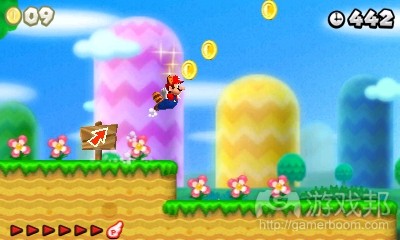设计师应有效引导玩家以优化游戏体验
作者:Adam Russell
作为设计师,你得时刻清楚你想让玩家做什么,但知道这一点并不意味着玩家真的会这么做。
确保玩家不会在游戏中不知所措是游戏设计的一大重要原则,因为手足无措的玩家迟早会受挫,而受挫玩家则可能一去不返地离开游戏。
即使是在相对较小的游戏中,也可能出现一些导航问题,因此所有游戏设计师都必须掌握设置有效路标这一重要技能。有些设计师开工时可能习惯于优先创造精美的图像等内容,但首先决定玩家在游戏世界中要做什么,你希望他们走哪条路可能才是一个更好的出发点。
《超级马里奥兄弟2》在路标设置这一点上十分用心,从以上截图就可以看出这一点。但即使其中没有设置红色的大箭头,图中也还有其他形式的路标。图中的金币布局驱使玩家上移视线,告诉玩家追随条路径可以获得奖励。这一点就再明显不过了,如果玩家乘坐超级树叶沿该方向一飞冲天,他们就会找到隐藏其中的星星币。
我们还有许多方法可用于引导玩家,例如:
UI:即使你的游戏主要围绕UI而成形,你也还是得清楚自己想让玩家摁压哪个按钮。如果你想让玩家去点击某个特殊按钮,那就要让这个按钮显得与众不同。可以把它设计得更大,更鲜明或者添加视觉特效。如果你玩过社交游戏,你就会注意到其中的“分享”按钮通常最为醒目,而“关闭”按钮却相对较小。
地图:这一设计多用于拥有大型中心枢纽的沙盒游戏,地图是一种为玩家呈现下一个目标的绝佳方式。可以使用不同的图标区分不同目标,但要注意不要使用过多图标,导致玩家难以消化。
地标:在游戏中设置一座漂亮养眼的建筑,玩家很可能就会进入其中一探究竟,如果结合NPC角色等技巧,这种方法还会更有效果。
NPC角色:让游戏中的角色直接与玩家交流,为后者派发任务或开启新的游戏区域。这些角色要吻合其所处环境,这样它们就可以为迷失方向的玩家提供更详细的指示。
音频:使用音频提醒玩家远离危险区域,或者诱使他们转向其他地点。《时之笛》中的The Lost Woods章节就是巧妙使用音频引导玩家走出迷宫的典型。
可视化差异性:许多游戏都有些拥有不同主题的世界,这些世界不仅玩法有所区别,还可以为玩家提供新的挑战,但同时也具有引导玩家的作用。在此要注意,假如NPC给你派了一个去沙漠的任务,而你周围却是雪人,那你很可能就会走错路。
无论你制作的是哪种游戏,都不可忽视引导玩家这个重要设计。在确保玩家不会茫然无措的同时,也要避免向其灌输过量的选择信息。要让玩家获得一种主导权,最好是使用温和的提示来引导玩家,而不是强硬地驱使他们。(本文为游戏邦/gamerboom.com编译,拒绝任何不保留版权的转载,如需转载请联系:游戏邦)
Improving player experience through signposting
by Adam
As a designer, you should always know what you want the player to do, but just because you know what the player should be doing doesn’t mean that they do.
Making sure that a player doesn’t get lost is an important part of the game’s design, as a lost player is likely to become a frustrated player. And a frustrated player isn’t likely to be your player for long.
Navigation can become an issue even in relatively small games, so effective signposting becomes an essential skill for all designers. As tempting as it may be to begin development by creating amazing graphics and set-pieces, a better starting point would be to decide what you want the player to do in an environment and the route you want them to take through it.
New Super Mario Bros. 2 takes signposting very literally, as shown in the screenshot above. But even without the big red arrow there is another form of signposting in the shot. The placement of the coins draws the player’s eye up, and suggests that there is a reward for following that line. Sure enough, if a player uses the super leaf and flies up in that direction, they will find a hidden star coin.
There are plenty of ways to help guide the player, such as:
UI – Even if your game is primarily UI based, you should still know which buttons you want the player to press. If you have a particular button that you want a player to click, make it stand out more than the others. Make it bigger, more colourful or add a visual effect. If you’ve played any social games before you’ll have noticed that the ‘SHARE’ button is more often than not the most obvious, and that you have to hunt for the tiny close button.
Maps – Most commonly used in sandbox games with big centralised hubs, maps are a great way to show a player where the next objective is. Use different icons to differentiate between different targets, though be mindful to avoid overloading the player.
Landmarks – By putting an interesting looking building on the horizon, players are likely to want to investigate it, especially if used in conjunction with other techniques such as NPC characters…
NPC Characters – Characters within the game can interact directly with the player, sending them on a quest or opening up a new area of the game. They can also be context sensitive so that if a player has appeared lost for a while they can give more detailed instructions.
Audio – Use audio to warn players away from dangerous areas or to entice them to others. The Lost Woods section in Ocarina of Time made excellent use of audio cues to guide the player through the maze.
Visual Distinction – Many games have themed worlds, which not only break up the gameplay and can present new challenges but can also guide the player. If an NPC character has sent you on a quest to the desert and you’re surrounded by snowmen, you’re likely to have gone the wrong way.
Whatever game you make, deciding how you guide the player will be part of the design. While you don’t want the player to become lost, you also don’t want them to be overloaded with options. The player needs to feel in control, so use gentle nudges to guide your players rather than sticking them on rails. Unless that’s what you’re designing.(source:adamrusselldesign)











































